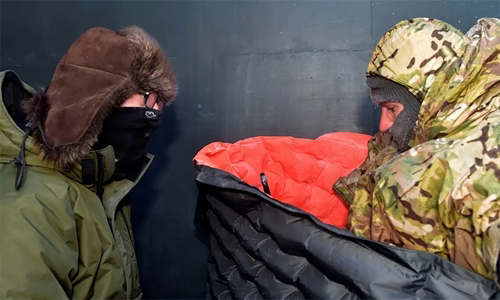The team of pilots sat in a freezer simulating a temperature in Alaska to try out the new Arctic survival kit for the F-35 fighter.
In a test that took place on November 5 in Fairbanks, Alaska, two freezers were set at -28 degrees C and -40 degrees C for four pilots in standard aircraft to enter, then calculated the time to wear the page. Cold resistant clothing is included in the survival kit.

Technician Sergeant Garret Wright (left) monitors the condition of Lieutenant Colonel James Christensen during a polar survival kit test in Fairbanks, Alaska on November 5 Photo: US Air Force
F-16 fighters deployed at Eielson Air Base in Alaska have survival kits in the cold, but they do not fit under the F-35 fighter pilot seat. Three technical sergeants John Williams, Benjamin Ferguson and Garret Wright develop new survival kits with smaller dimensions.
"The kit includes a raft that can be used as a shelter, wool gloves, 12 hour hand heaters, blankets, multitasking gloves, small saws, shovels, flares and beacons. to fit under the F-35 pilot seat, 60-70% of the space on an F-16, "Wright said.
Technical sergeant Wright is responsible for recording the status of the pilot group every 30 minutes to ensure the safety and accuracy of the test. After about 5 hours of testing, Sergeant Wright discovered that the electronic thermometer was not displaying the correct temperature in a freezer. Wright found a mercury thermometer and discovered the temperature in one cabinet was -53 degrees Celsius, the other one was -46 degrees Celsius.
"After realizing that the temperature in a freezer of -53 degrees C and 5 hours had passed, I knew the group was successful beyond expectations. The commanders wanted the product to help the pilot survive in -40 conditions. degree C. Although not prepared in advance, we discovered the toolkit can go beyond the set target, "Wright said.
Lieutenant Colonel James Christensen, commander of the 356 fighter squadron, participated in the test and said that although the toolkit was uncomfortable, it would help pilots survive many hours after an accident and wait for rescue.
Eielson Air Base in Alaska is expected to receive the first F-35A fighters in April 2020. Before the two F-35A squadrons are deployed here, they must undergo rigorous testing to ensure they can operate in extremely cold weather, including landing in icy conditions and temperatures. air -45 degrees Celsius.



 EvelynSapioPeras
EvelynSapioPeras







